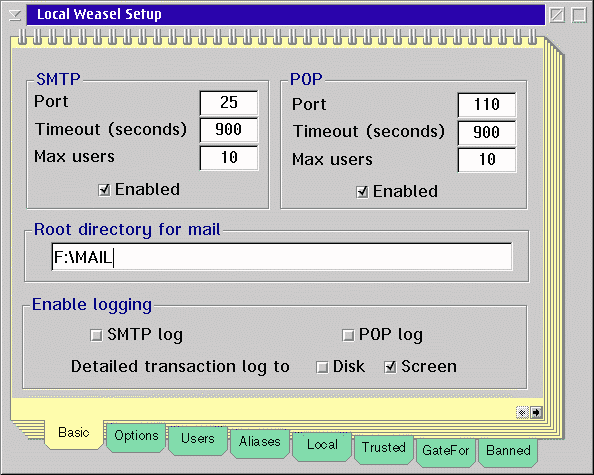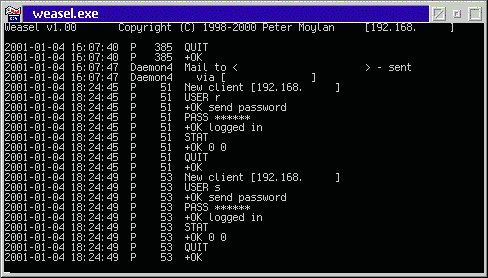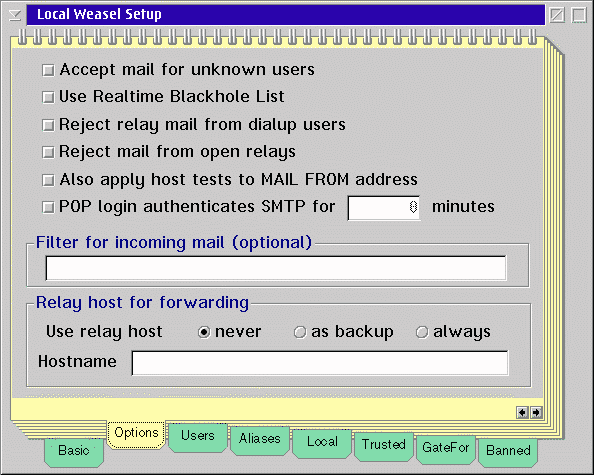
16 January 2001
Robert Basler is the president of Aurora Systems, Inc., as well as OS/2 eZine's new Editor in Chief. He doesn't really know what he's getting into, and the guy he's replacing doesn't want to scare him off by telling him. ;-)
If you have a comment about the content
of this article, please feel free to vent in the OS/2
eZine discussion forums.
|
Previous Article |
|
Next Article |
Your Own E-Mail Server with Weasel
on OS/2
Recently I decided it was time to move my company's
website to my own server so that I could offer some additional services to my customers
without the hassle of dealing with various ISP's. One service I was really looking
for was my own email address at my own domain. While domain hosting is available
from most ISP's for a reasonable fee, and usually includes 5 email addresses plus
some amount of web space, running my own web server I found it much more flexible
and economical to run my own email server as well.
I have been running Weasel 1.0 the
last couple months, but in December, Peter Moylan came out with Weasel 1.10. I have
not upgraded our mail server yet, although I will be looking at version 1.10 here
and an upgrade is probably in my near future.
Setup
Once you have your own domain name,
the first thing you need to do is contact whoever is providing the DNS service for
your domain and get them to add MX (Mail Exchanger) records to the DNS records for
your domain. Although your server may work without MX records, you will find that
some people have trouble sending you mail if you don't. If you are running all your
servers on a single machine, it is also a good idea to add a DNS record for your
server like mail.yourdomain.com in case any of the servers on your domain ever outgrow
their current home.
Installing Weasel is a snap. Unzip
it to the directory where you wish it to be installed, making sure to preserve the
directory structure in the zip, create a directory where mail in-transit will be
stored (like C:\MAIL) then run the included MAKEFOLDER.CMD if you want icons on
your desktop.
Once Weasel is installed, you need
to run the included SETUP.EXE to actually configure the mail server for use. Note
that there are both VIO and PM versions of Setup included if you prefer character
mode programs. To help you figure out the options in Setup, use the online help.
The help here is simple and straightforward, offers helpful suggestions for configuration,
and even spends time discussing the why's of things.
One feature that Setup offers that
I have not tried is remote configuration which allows you to administer your email
server from anywhere. This is particularly important if your mail server is offsite,
perhaps at the offices of your ISP.

The most important information to
enter is the directory for your email, the backup relay host (provided by your ISP)
in case someone refuses mail coming directly from you, the name of the local domain
(mail.yourdomain.com, yourdomain.com), and the acceptable sources for relay mail.
After you are satisfied with the
operation of Weasel, you probably need to set it to start automatically when the
computer is started. You can do this by adding a command to start Weasel to the
TCPSTART.CMD file. You can also run it from INETD if you have very low traffic levels
but the documentation doesn't recommend this. Once you are satisfied Weasel is working
as you need, you can run Weasel detached, although you will not get a console so
that you can see any status messages Weasel might generate. In any case, I would
recommend running Weasel as a normal process at first.

Preventing Relaying
Relaying is the process where one
email server asks another email server to deliver a message for it. While this is
absolutely necessary for mail to transit the internet, in general, as a tiny postoffice,
you do not want to provide this service for others. I was particularly concerned
about this since I pay on a per-byte basis for my connection and had heard of one
fellow who watched his email server grind through several gigabytes of spam mail
overnight because he allowed unlimited relaying. Fortunately, Weasel is naturally
inclined against relaying, you must explicitly enter either the senders or recipients
who you are willing to relay mail for. If relaying is what you need, such as when
your server is acting as a gateway to a private subnet, it is still straightforward
to configure Weasel for this.
SPAM Prevention
One of the biggest problems of email
today is spam. I receive an average of 10 per day. Fortunately, Post Road Mailer's
filters take care of them for me so I don't usually have to see them. You can read
about that in the May 2000 issue of the OS/2 e-Zine (http://www.os2ezine.com/20000516/spam.html).
If you aren't using such a handy mail client, you can have Weasel take care of some
of this for you.

Weasel includes optional spam prevention
features which should satisfy even the most paranoid. Each time someone attempts
to send mail through Weasel, it can be set to consult the MAPS RBL (Realtime Blackhole
List) to see if the sending SMTP server is a known spammer and if it is, reject
mail from there.
Weasel can also be set to reject
email from email servers running on dialup connections through a consultation with
the MAPS DUL. Often spammers will use throwaway dialup accounts to broadcast their
messages.
A much more severe restriction Weasel
supports is to reject mail from email servers that have open relays, that is, they
will relay mail from anyone. The theory here is that it punishes ISP's who allow
open relays by preventing anyone on their domain from sending email to you. The
only ones I see it punishing is the users on that domain that you probably want
to hear from.
Weasel also supports simple host
blocking if you have someone consistently sending you spam as well as more advanced
filtering and spam detection features such as automatic operation of an external
program on each email Weasel processes.
As a non-spammer who has been on
the receiving end of such facilities, I did not choose to enable any of these functions
initially. I have had emails I have sent rejected as spam based simply on my email
server, despite the fact that my ISP is the largest in Canada with several million
users. Perhaps if the spam volume on my server goes up I will reconsider.
Setting up Accounts and Aliases
For each user you want to have on
your server, you need to set up an account. Generally all that is needed is the
account name and password. Once these are created, people will be able to send mail
to yourname@yourdomain.com and you will be able to use a POP3 email client to retrieve
that mail. Weasel will create a separate subdirectory under its main Mail directory
to store each account's messages.
One big factor that made me choose
Weasel over other available OS/2 mail servers I looked at was the unlimited number
of accounts I could create with it. The other servers I looked at charged you by
the number of email addresses you wanted. I could see 6 or so I would need just
for myself, but I didn't want to pay a whole lot extra for them.
Aliases are a great feature for businesses
and server administrators alike. An alias is basically a mailing list, you create
an alias name like alias@yourdomain.com then you can enter as many email addresses
as you like which will receive any notes sent to the alias email address. The email
addresses on the list don't even have to be local, Weasel can send the alias messages
to any email address, so you could use this feature to provide discussion lists.
Another extremely handy use for aliases
is if you are the site administrator and you have an email address like yourname@yourdomain.com
and you don't want to have to check different email accounts for all the standard
administrative email addresses like abuse@yourdomain.com, webmaster@yourdomain.com,
root@yourdomain.com etc. If you create an alias for each of those email addresses
and point all of them to yourname@yourdomain.com, they will all be routed to a single
mailbox.
You can do the same for your sales
or technical support department, creating aliases like help@yourdomain.com, support@yourdomain.com,
itsbroken@yourdomain.com and so on.
Troubleshooting
When I initially set up Weasel, I
had some problems with some emails not getting sent. The error messages on the console
indicated that the mail sessions to the remote mail servers were simply hanging.
A quick email to Mr. Moylan offered up a likely reason for this problem and a solution.
The problem was that in an attempt
to control SPAM, some of the larger ISP's like Yahoo do not accept mail from mail
servers not meeting some unpublished criteria. Evidently my server met those criteria,
however rather than returning an error message to Weasel, they simply hang the session
in an attempt to slow spammers. I found this all particularly ironic considering
that the bulk of the junk mail I get in a week comes from either Yahoo or Hotmail.
The solution was to use Weasel Setup,
click on the Options tab, and enter my ISP's SMTP server in the Relay Host for Forwarding
box and select the Use Relay Host as Backup radio button. This causes Weasel to
first attempt to send mail itself directly to the destination, then if that fails,
to try relaying the email through my ISP's SMTP server. Before you do this, you
will have to contact your ISP to make sure that your ISP's SMTP server is configured
to allow you to relay mail.
Another problem I had was that I
could not immediately send mail, even from another computer on my LAN. I hadn't
set the Trusted hosts entry in the Setup program. After entering the range of IP
addresses used on my LAN (192.168.0.0-20) into the Acceptable Sources for Relay
Mail, everything started working. See the online help for more information about
specifying ranges and hosts.
Great Customer Service
I really have to commend Mr. Moylan
on his email responses to my questions, they are prompt and courteous, something
that I find very refreshing compared to the lackluster customer service I typically
see in todays software marketplace.
Retrieving Mail
Retrieving mail is just like you
do from a regular ISP, configure your mail client for POP3 mail retrieval with the
name of the mail server (mail.yourdomain.com) as well as your user name and ID.
Generally mail clients use POP3 to retrieve mail and SMTP to send it.
Sending Mail
Sending mail is also just like you
do for a regular ISP, configure your mail client to send using SMTP with the name
of the mail server (mail.yourdomain.com.) As I mentioned above, make sure you enter
the IP range of all the computers on your LAN so that you can send mail from any
of those computers.
Remote Access
If you ever use another computer,
say from a dialup account provided by an ISP, to access your mail, you will likely
find you can't send mail through Weasel. This is most likely because you have forbidden
relaying (a really good idea.) To handle this case, Weasel includes a special feature
called POP before SMTP Authorization. This allows a user who retrieves mail using
POP3 to relay (send) mail using SMTP for a given number of minutes afterwards. I'd
recommend setting this to 10 minutes or so, and then configuring your email client
to always retrieve mail before sending it.
Summary
Is Weasel worth trying? Definitely!
On my Pentium web server, Weasel simply runs. Week after week without a complaint.
There isn't a much better recommendation than that. Do take the time to read through
the documentation though, Weasel does quite a few more interesting things I haven't
covered here.
Be sure to check out Mr. Moylan's
website, it lists quite a bit of affordable, interesting software for OS/2 including
an FTP server and a mailing list manager.
|
Previous Article |
|
Next Article |